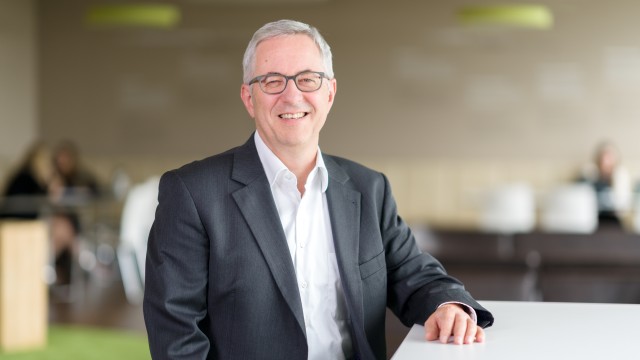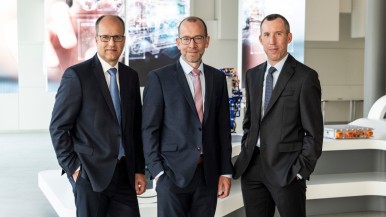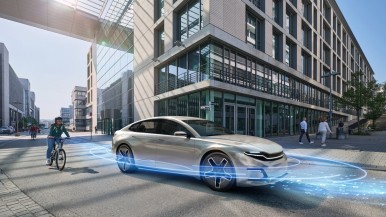Ladies and gentlemen,
I would like to start by taking a look into the not-too-distant future, and the year 2020. By then, Bosch wants to lead the emerging mass market for electromobility. That is our objective. In this endeavor, we are relying on our systems expertise and the development and manufacture of key components, such as the electric motor, power electronics, and battery systems. In this way, we want to become the go-to partner for electric driving.
Our electromobility strategy goes far beyond the powertrain, for Bosch’s expertise covers the entire electromobility ecosystem – from proven components for electrified applications to digital connection with the charging infrastructure. We are drawing on old and new core competencies to secure and gain market share. Later, I will explain the three core elements of our strategy – systems expertise, energy efficiency, and standardization – in more detail.
Battery cells: outsourcing instead of in-house manufacturing
Let me start by announcing a decision on a matter that has been the subject of a lot of speculation in recent months. Is Bosch going to start manufacturing its own battery cells? The answer is “no.” Bosch will continue to buy in the cells needed to make batteries. We are convinced that battery cells will be a standardized commodity in the long run. We have to understand cells technically, we don’t have to make them ourselves. We now know that we will be electromobility leaders even without cell-manufacturing operations of our own. Cell production is not decisive for our success. When it comes to cells, it also holds true that they are just one component of a complete system. It is systems expertise that will be decisive. In other words, we will stick to our successful recipe of drawing up specifications for cells with our suppliers, buying these cells from them, and using our electronics expertise to combine and refine them in battery systems.
Let me go into the reasons behind our decision in more detail:
Technically speaking, we have made excellent progress in cell development. In our development joint venture with GS Yuasa and Mitsubishi, we have concluded our research into lithium-ion technology. In concrete terms, this means that the next-generation lithium-ion cells we have developed are on a par with those of Asian competitors. The end of our research work also means the end of the joint venture. We want to continue working with our two former partners in the future.
The research done by our Seeo start-up goes one step further, into solid-state technology or post-lithium-ion technology. Here too, we have made significant technological progress. Solid-state technology is the way forward for the manufacture of mass-marketable batteries from the middle of the next decade. Solid-state technology offers the possibility of doubling batteries’ energy density and more than halving their costs. However, this calls for even more R&D expenditure. We are currently in talks with interested parties that will continue Seeo’s research work.
Regardless of development progress, cell manufacturing is not just a question of technology: entering into cell production is above all a commercial undertaking that has to make economic sense. Our aim is to lead the fields in which we operate. In the case of cell manufacturing, what would that mean in concrete terms? By 2030, some 1,000 gigawatt hours of battery capacity will be required worldwide. In order to secure a market share of 20 percent and, with it, a leading position, an investment of some 20 billion euros would be necessary for a manufacturing capacity of 200 gigawatt hours. Given dynamic external market factors that can only be predicted with difficulty, it is unclear whether such an investment would pay off for Bosch, and when.
Why is that? For new entrants, the market conditions are more than challenging. Five Asian manufacturers currently dominate the market. They already produce huge volumes of cells, and thus have significant competitive advantages.
Even if we had a large market share, the business risk would be high for us. Since the cost of materials – including raw materials – accounts for three-quarters of cells’ manufacturing cost, there only remains a narrow scope for creating and exploiting competitive advantages.
Following an assessment of the economic factors relating to the establishment of cell manufacturing operations, we concluded that investing in future cell technologies – whether improved existing technologies or future ones – is too risky. In the interest of the company as a whole, such an investment cannot be justified.
We will therefore continue to buy in cells in the future, and not manufacture them ourselves. I want to emphasize that this is a “no” to cell manufacturing operations of our own, but a “yes” to batteries at Bosch. After all, we have built up considerable cell-technology expertise over the years. In a center of competence, Bosch will continue to add to the comprehensive battery-cell expertise it has built up over recent years. As was occasionally the case in the past, moreover, several hundred associates will continue to work on battery systems. They will develop battery-management systems and 48-volt battery systems, and draw up the specifications for cells. We see huge potential for 48-volt battery systems. By 2030, a 48-volt system will support the combustion engine in 20 percent of new vehicles. This year will see the start of production of a new generation of 48-volt batteries that are also suitable for compact and sub-compact cars. Our USP here is our systems expertise and our ability to draw up specifications for cells together with suppliers. Our customers also benefit from our expertise in product design and materials research.
We will use the technology development work at the center of competence not only for mobility applications but also products from other parts of Bosch, such as household appliances and power tools. So much for battery-cell manufacturing.
The go-to partner for electric driving
Ladies and gentlemen, we want to be the go-to partner for electric driving. We are already a leader in the powertrain field – and we will be in the future as well. Our strategy takes account of the currently dynamic developments in the electromobility market. We are currently seeing the emergence of a market in which the deck is being reshuffled and the first orders are being placed, worth billions of euros. Last year, we won 20 new orders relating to electromobility. We want to build on this, and gain market share and extend our position in a rapidly growing environment. Our strategy rests on three pillars, which I would like to explain to you in detail: systems expertise, energy efficiency, and standardization.
Pillar #1: Systems expertise
Our first core competency is systems expertise. This has always been the key to Bosch’s success. And we are relying on it in electromobility as well. Our customers benefit from our expertise in intelligently linking all the components in the powertrain. This broad-based systems expertise is our USP. The Bosch portfolio includes key components of the electrical powertrain, such as the electric motor, power electronics, and battery systems.
Our systems expertise goes beyond the electric car’s hood. Our “system!e” which we recently premiered connects the electrical powertrain with the Bosch Automotive Cloud Suite. This gives rise to web-based services that enhance the everyday benefits of electromobility. The charging assistant is one example. Let’s say someone is driving from Munich to Hamburg. The assistant knows where all the charge spots along the route are, plans recharging stops in advance, and deals with all payment transactions. And with additional information about restaurants, cafés, and places to shop, drivers can make better, more relaxed use of the recharging break.
Pillar #2: energy efficiency
Our second core competency is energy efficiency. Our electric motors and eAxle already lead the way here. The less electricity the motor and other components consume, the long the battery charge will last, and the greater the range. This is an area in which our engineers are working on new generations of electric motors, inverters, and battery systems. Modified thermal management systems can also increase electric cars’ range by up to 20 percent.
Pillar #3: Standardization
Our third core competency is standardization. For us, this is the basis for making mass-market electromobility scalable and affordable. The eAxle, our latest electric drive, is evidence of this. We sell this electric axle drive to a wide range of customers – to established automakers and start-ups alike. As Bosch can quickly and flexibly adapt the drive to the automakers’ requirements, customers have no need for time-consuming new designs, which speeds up their development times.
There’s a saying in our company that there’s no car on the planet without a bit of Bosch in it. In the future, this will have to be extended to include electric cars. Wherever you look under the hood – be it in Asia, Europe, or North America – you’ll always find the Bosch armature in a circle. Our electromobility unit will play a leading part in shaping the dynamic transition to electric driving. In this transformation process, we will be there to support our customers with knowledge and technology. Even now, Bosch technology can be found in more than 800,000 electric vehicles and hybrids worldwide.
And it’s not just the car we are electrifying. Our technology can be found in practically every class of vehicle: we develop and manufacture components for electric bicycles, scooters, passenger cars, and commercial vehicles. In the electromobility business, no other automotive supplier is as broadly diversified as Bosch. What’s more, we are at home in the entire electromobility ecosystem – from proven components for electrified applications to digital connection with the charging infrastructure. Our customers benefit just as much from this market experience as from our global research and development network. The latter allows Bosch to carry out projects flexibly and close to its customers, whether in Asia, Europe, or North America.
Thank you.





